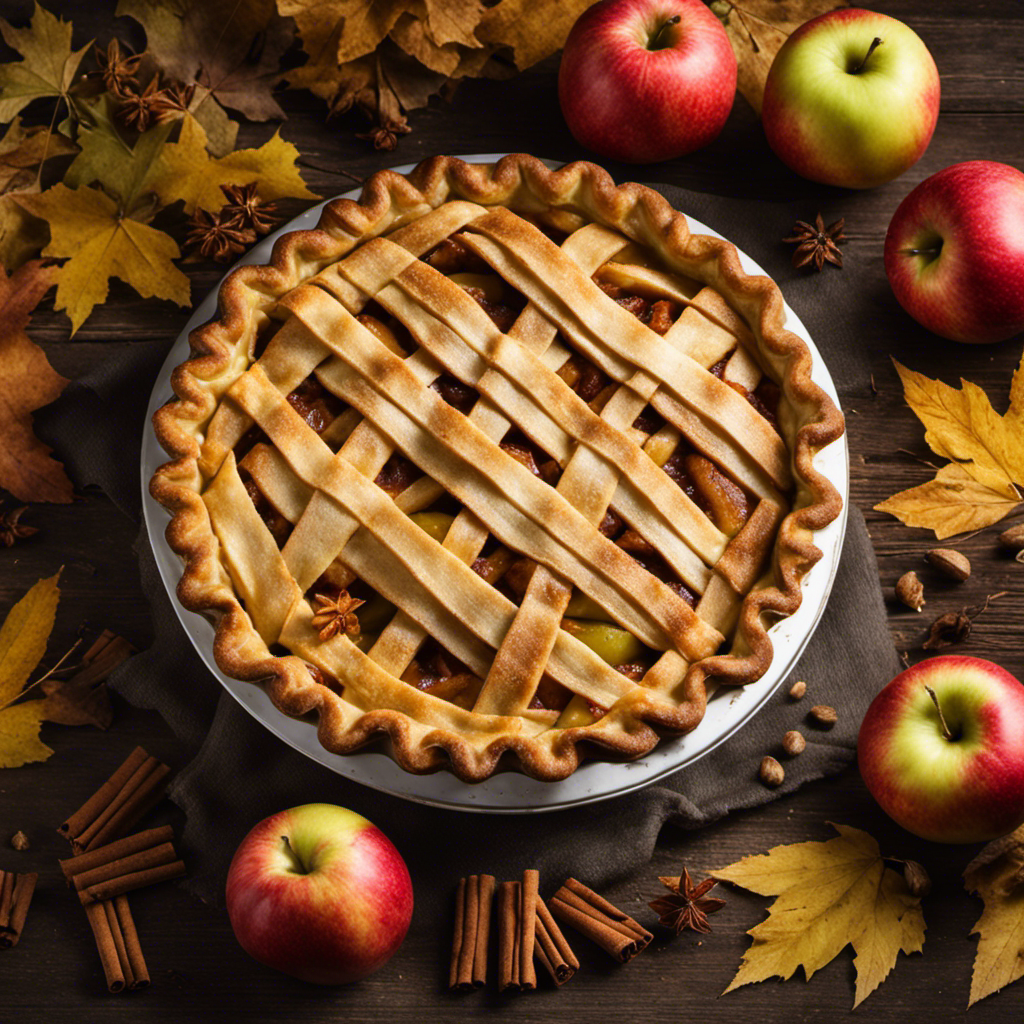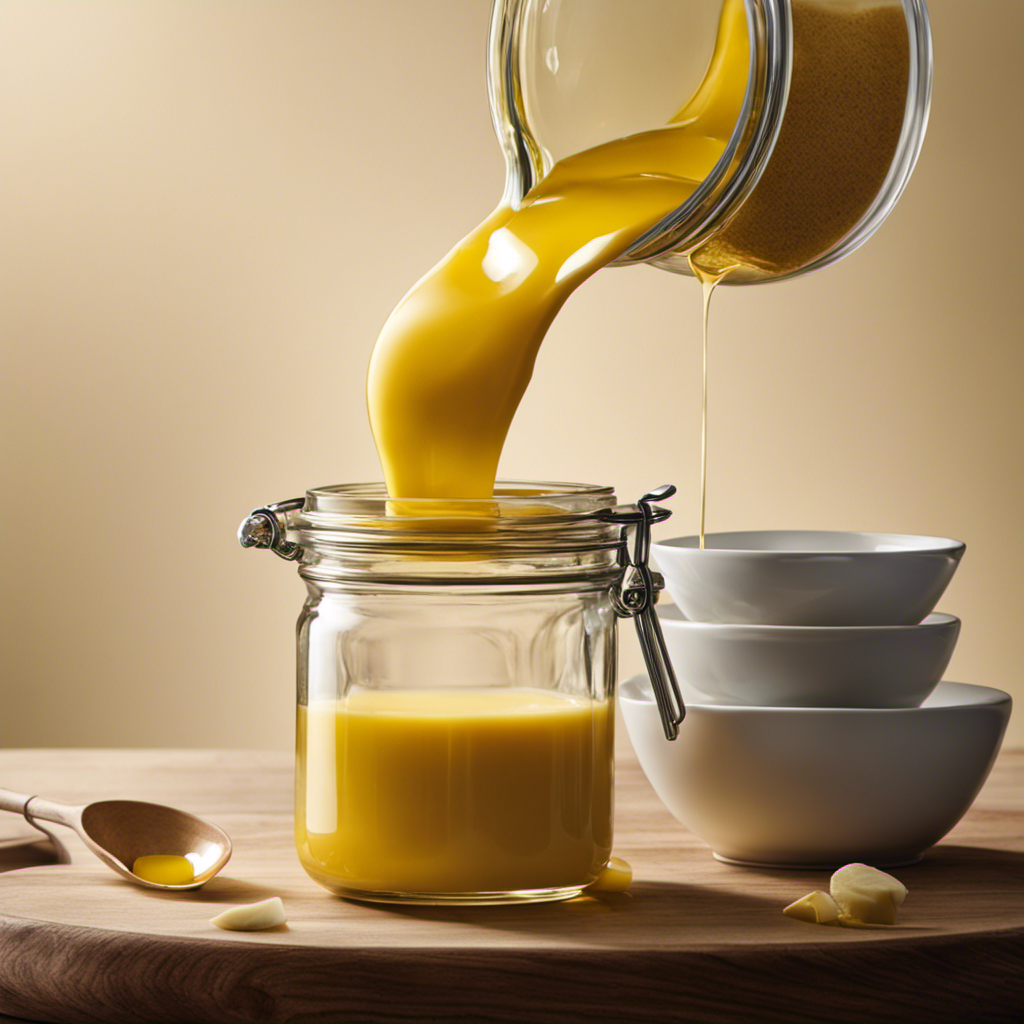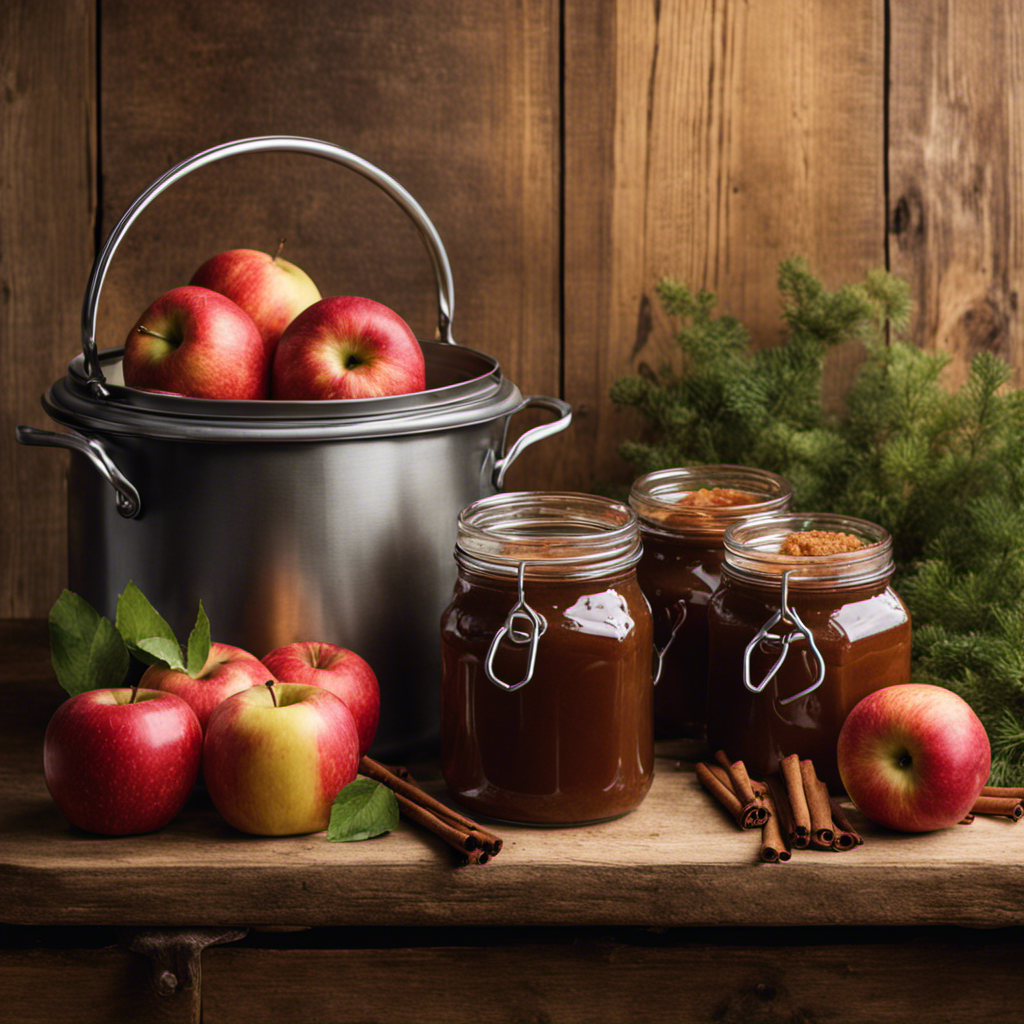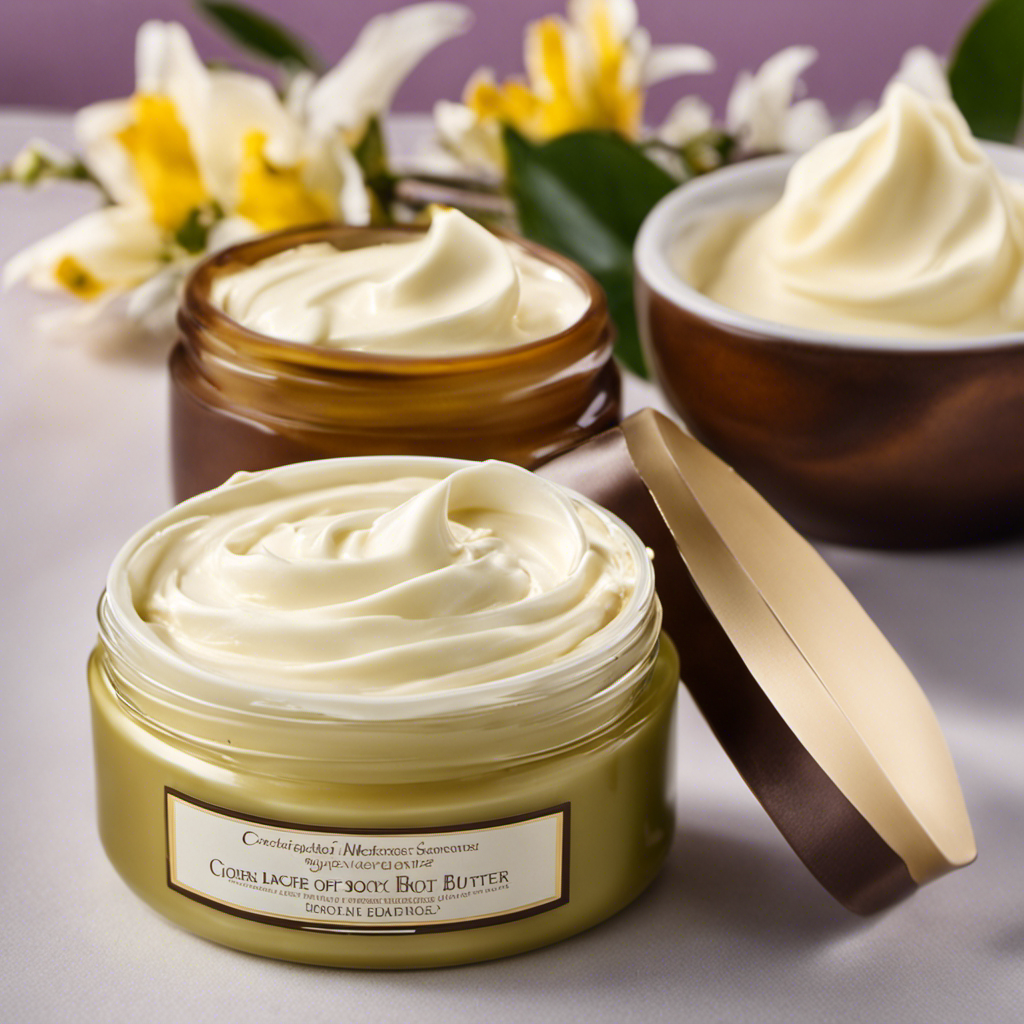As a passionate home cook, I have always been intrigued by the scientific principles behind the changes in ingredients. One process that I find especially fascinating is the melting of butter.
Picture this: a golden stick of butter slowly softening and turning into a velvety pool of liquid. But have you ever wondered at what temperature this magical metamorphosis occurs?
In this article, we will delve into the melting point of butter and uncover the factors that influence this culinary phenomenon. Get ready to unlock the secrets of butter melting!
Key Takeaways
- Factors such as fat content and water presence affect the melting point of butter.
- The molecular structure of butter determines its melting point.
- Observation of glossy surface and smooth texture helps determine the ideal temperature for melting butter.
- Different forms of butter have different melting points.
The Melting Point of Butter
Do you know what temp butter melts at?
When it comes to butter, its melting point can vary depending on a few factors affecting its consistency.
The first factor is the fat content of the butter. Butter with a higher fat content tends to have a lower melting point.
Another factor is the presence of water in the butter. Water can lower the melting point of butter and make it melt at a lower temperature.
To melt butter smoothly, there are a few techniques you can use.
One technique is to cut the butter into small pieces before melting it. This helps the butter melt evenly and prevents it from burning.
Another technique is to melt the butter slowly over low heat, stirring constantly to ensure uniform heat distribution.
Factors Affecting the Melting Point of Butter
To determine the factors that affect the melting point of butter, you’ll need to consider various elements such as temperature, composition, and processing methods.
The melting point of butter is influenced by these factors, which can affect the consistency and texture of the butter.
Temperature plays a crucial role in determining when butter melts, as it undergoes a phase transition from solid to liquid.
Composition refers to the fat content and water content of the butter, as well as any additives or flavorings that may be present.
Processing methods, such as churning and homogenization, can also impact the melting point of butter.
Experimental methods for measuring butter melting point include using a melting point apparatus or conducting differential scanning calorimetry (DSC) tests.
These techniques provide precise and accurate measurements of the melting point, allowing for a better understanding of the science behind butter melting.
Understanding the Science Behind Butter Melting
By considering factors like temperature, composition, and processing methods, you can gain a deeper understanding of how butter undergoes a phase transition from solid to liquid.
The butter melting process is primarily influenced by its molecular structure. Butter is composed of water, milk proteins, and milk fat. At lower temperatures, the milk fat molecules are arranged in a solid crystalline structure.
As the temperature increases, thermal energy is transferred to the butter, causing the molecules to vibrate more vigorously. This increased energy disrupts the solid crystalline structure, and the butter begins to melt. The temperature at which this phase transition occurs is known as the melting point of butter.
The molecular structure of butter plays a crucial role in determining its melting point, as variations in the composition and processing methods can alter the arrangement and stability of the molecules, affecting the melting behavior of the butter.
How to Determine the Ideal Temperature for Melting Butter
When melting butter, you can determine the ideal temperature by observing its consistency and texture. Here are three techniques to help you find the perfect temperature for melting butter:
-
Observation: Keep a close eye on the butter as it melts. Once it starts to melt and the surface becomes glossy, it means it has reached its ideal temperature.
-
Texture Test: Use a spoon or spatula to stir the melting butter. If it feels smooth and creamy with no lumps, it is at the right temperature. If it appears grainy or separated, it may be too hot or too cold.
-
Time and Heat Control: Gradually melt the butter over low heat to prevent it from burning or becoming too runny. Adjust the heat as needed and allow enough time for the butter to melt evenly.
By using these techniques, you can ensure that your butter melts at the ideal temperature for your recipe.
Now let’s explore the different forms of butter and their melting points.
Different Forms of Butter and Their Melting Points
If you’re using different forms of butter, it’s important to know their melting points.
Different forms of butter, such as unsalted, salted, clarified, and whipped, have varying melting point variations.
Unsalted butter has a lower melting point, typically around 90°F (32°C), due to its higher fat content.
Salted butter, on the other hand, has a slightly higher melting point of around 95°F (35°C) because of the added salt.
Clarified butter, which has the milk solids removed, has a higher melting point of around 104°F (40°C).
Whipped butter, which has air incorporated into it, has a lower melting point, around 85°F (29°C).
Knowing these melting points can help you determine the best method and temperature for melting butter without burning it.
Tips for Melting Butter Without Burning It
When it comes to melting butter without the risk of burning it, there are a few key techniques to consider.
The first is low heat melting, which involves slowly heating the butter over a gentle flame or on a low setting in your stovetop.
Another option is the microwave melting technique, where you can melt butter in short intervals, stirring in between to ensure even melting.
Lastly, there is the clarifying butter method, which involves slowly melting butter and separating the milk solids from the pure butterfat.
These methods can help you achieve perfectly melted butter without any unwanted burnt flavors.
Low Heat Melting
Melting butter on low heat is a great technique for cooking delicate sauces. When using low heat, the butter slowly melts without burning or browning, ensuring a smooth and creamy texture. Here are three reasons why low heat melting is beneficial:
-
Retains flavor: Low heat cooking allows the butter to melt gradually, preserving its rich and nutty flavor. This ensures that the butter enhances the taste of your sauces without overpowering them.
-
Prevents separation: By melting butter on low heat, you minimize the risk of separation. The gentle heat allows the fat and water content in the butter to combine smoothly, resulting in a cohesive and velvety sauce.
-
Controls temperature: Low heat provides better control over the melting process. This prevents the butter from overheating and turning brown, which can alter the taste and appearance of your dish.
Transitioning into the subsequent section about the ‘microwave melting technique,’ it is worth noting that while low heat melting is effective, there are alternative methods that offer convenience and speed.
Microwave Melting Technique
Transitioning into the subsequent section about the ‘microwave melting technique,’ it’s worth noting that this method offers convenience and speed. When using a microwave to melt butter, it is important to take certain safety precautions.
First, always use a microwave-safe container and cover it with a microwave-safe lid or microwave-safe plastic wrap to prevent any splattering. Additionally, it’s crucial to microwave the butter in short intervals, stirring in between each interval, to ensure even melting and prevent overheating.
It’s important to mention that there are alternative butter melting methods available, such as using a double boiler or melting the butter on the stovetop over low heat. These methods may require more time and effort, but they provide more control over the melting process.
Transitioning into the subsequent section about the ‘clarifying butter method,’ let’s explore another technique for melting butter.
Clarifying Butter Method
To clarify butter using the traditional method, you’ll need a saucepan and a spoon. Clarifying butter offers several benefits, including removing impurities and increasing its shelf life.
Here is a step-by-step process for clarifying butter:
- Melt the butter in a saucepan over low heat.
- Skim off any foam that rises to the surface with a spoon.
- Slowly pour the clarified butter into a separate container, leaving behind any sediment at the bottom.
By following these steps, you will have a clear, golden liquid that can be used for various cooking purposes. Clarified butter has a higher smoke point, making it ideal for sautéing and frying without the risk of burning. It also has a longer shelf life compared to regular butter.
Now, let’s transition into the next section about common mistakes to avoid when melting butter.
Common Mistakes to Avoid When Melting Butter
When it comes to melting butter, it’s crucial to pay attention to the correct melting temperature. This ensures that the butter doesn’t burn or become too greasy.
Additionally, controlling the consistency of melted butter is important for achieving desired results in baking and cooking recipes.
Correct Melting Temperature
You’ll want to make sure your butter melts at the correct temperature. The ideal melting temperature for butter is around 90 to 95 degrees Fahrenheit (32 to 35 degrees Celsius). This ensures that the butter melts evenly and maintains its flavor and texture.
Here are three key points to keep in mind when melting butter:
-
Use low heat: It’s important to melt butter slowly and gently to avoid burning or browning. Start by melting the butter on low heat and gradually increase if needed.
-
Use a double boiler: A double boiler is a great tool for melting butter as it helps to control the temperature and prevents direct heat contact. Simply place a heatproof bowl over a pot of simmering water and melt the butter in the bowl.
-
Stir occasionally: While melting the butter, make sure to stir it occasionally to promote even melting and prevent any hot spots. This will ensure that the butter melts uniformly and avoids any lumps or clumps.
Butter Consistency Control
Maintaining the desired consistency of your butter is essential for successful culinary creations. To achieve this, butter consistency testing and butter melting experiments are crucial.
Butter consistency testing involves evaluating the firmness and texture of the butter at different temperatures. This can be done by chilling the butter and observing its response to pressure and spreading.
Additionally, butter melting experiments help determine the melting point of butter, which is vital for various recipes. By melting butter at different temperatures and monitoring its behavior, you can ensure that it reaches the desired consistency without becoming too runny or solid.
These tests provide valuable insights into the butter’s performance and allow you to adjust temperature and handling techniques accordingly, resulting in perfectly controlled butter consistency for your culinary endeavors.
Frequently Asked Questions
Can I Use a Microwave to Melt Butter?
Yes, you can use a microwave to melt butter. However, it’s important to follow microwave safety guidelines to prevent overheating and splattering. Alternatively, you can also melt butter on the stovetop or in a double boiler.
What Happens if I Heat Butter Above Its Melting Point?
When butter is heated above its melting point, it undergoes a process called thermal degradation. This can result in the formation of harmful compounds and a loss of flavor and nutritional value.
Can I Freeze Butter to Make It Easier to Melt?
Freezing butter for baking is an alternative way to soften it. By placing it in the freezer, the butter becomes firmer and easier to grate or melt. This can be helpful when precise measurements are required.
Is There a Difference in Melting Points Between Salted and Unsalted Butter?
The presence of salt affects the melting point of butter, causing it to melt at a higher temperature. This difference in melting points is attributed to the salt’s ability to disrupt the molecular structure of the butter.
Can I Use a Double Boiler to Melt Butter?
Using a double boiler is a safer method than direct heat for melting butter. The optimal temperature for melting butter is around 98-105 degrees Fahrenheit.
Conclusion
In conclusion, understanding the melting point of butter is essential for various culinary endeavors. By knowing the science behind butter melting, we can determine the ideal temperature to achieve the desired consistency and flavor in our dishes.
Just like a skilled conductor controls the temperature of a symphony, we must carefully monitor the heat to avoid burning the butter.
With proper knowledge and techniques, we can harness the transformative power of melted butter to elevate our culinary creations to new heights.
Let’s embark on this buttery journey with precision and passion!










